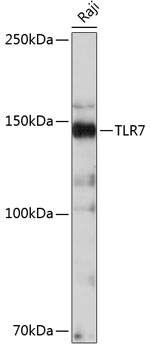Immunology Antibodies 3
Anti-TLR7 Antibody (CAB19126)
- SKU:
- CAB19126
- Product Type:
- Antibody
- Reactivity:
- Human
- Host Species:
- Rabbit
- Isotype:
- IgG
- Research Area:
- Immunology
Description
| Antibody Name: | Anti-TLR7 Antibody |
| Antibody SKU: | CAB19126 |
| Antibody Size: | 20uL, 50uL, 100uL |
| Application: | WB |
| Reactivity: | Human |
| Host Species: | Rabbit |
| Immunogen: | A synthesized peptide derived from human TLR7 |
| Application: | WB |
| Recommended Dilution: | WB 1:500 - 1:2000 |
| Reactivity: | Human |
| Positive Samples: | Raji |
| Immunogen: | A synthesized peptide derived from human TLR7 |
| Purification Method: | Affinity purification |
| Storage Buffer: | Store at -20°C. Avoid freeze / thaw cycles. Buffer: PBS with 0.02% sodium azide, 0.05% BSA, 50% glycerol, pH7.3. |
| Isotype: | IgG |
| Sequence: | Email for sequence |
| Gene ID: | 51284 |
| Uniprot: | Q9NYK1 |
| Cellular Location: | |
| Calculated MW: | 140kDa |
| Observed MW: | 140kDa |
| Synonyms: | TLR7, TLR7-like |
| Background: | The protein encoded by this gene is a member of the Toll-like receptor (TLR) family which plays a fundamental role in pathogen recognition and activation of innate immunity. TLRs are highly conserved from Drosophila to humans and share structural and functional similarities. They recognize pathogen-associated molecular patterns (PAMPs) that are expressed on infectious agents, and mediate the production of cytokines necessary for the development of effective immunity. The various TLRs exhibit different patterns of expression. This gene is predominantly expressed in lung, placenta, and spleen, and lies in close proximity to another family member, TLR8, on chromosome X. [provided by RefSeq, Jul 2008] |
| UniProt Protein Function: | TLR7: Key component of innate and adaptive immunity. TLRs (Toll-like receptors) control host immune response against pathogens through recognition of molecular patterns specific to microorganisms. TLR7 is a nucleotide-sensing TLR which is activated by single-stranded RNA. Acts via MYD88 and TRAF6, leading to NF-kappa-B activation, cytokine secretion and the inflammatory response. Interacts with MYD88 via their respective TIR domains. Interacts with UNC93B1. Detected in brain, placenta, spleen, stomach, small intestine, lung and in plasmacytoid pre-dendritic cells. Belongs to the Toll-like receptor family. |
| UniProt Protein Details: | Protein type:Membrane protein, integral Chromosomal Location of Human Ortholog: Xp22.3 Cellular Component: Golgi membrane; endoplasmic reticulum membrane; lysosome; endoplasmic reticulum; cytoplasm; integral to membrane; plasma membrane; endosome membrane; endosome; receptor complex Molecular Function:transmembrane receptor activity; single-stranded RNA binding; siRNA binding; double-stranded RNA binding; drug binding Biological Process: positive regulation of interleukin-6 production; positive regulation of interleukin-8 biosynthetic process; microglial cell activation; positive regulation of interferon-alpha biosynthetic process; positive regulation of NF-kappaB import into nucleus; toll-like receptor 7 signaling pathway; positive regulation of chemokine production; positive regulation of interleukin-8 production; MyD88-dependent toll-like receptor signaling pathway; positive regulation of interferon-beta biosynthetic process; toll-like receptor signaling pathway; innate immune response; toll-like receptor 9 signaling pathway; I-kappaB phosphorylation; inflammatory response; defense response to virus; positive regulation of inflammatory response; positive regulation of interferon-gamma biosynthetic process |
| NCBI Summary: | The protein encoded by this gene is a member of the Toll-like receptor (TLR) family which plays a fundamental role in pathogen recognition and activation of innate immunity. TLRs are highly conserved from Drosophila to humans and share structural and functional similarities. They recognize pathogen-associated molecular patterns (PAMPs) that are expressed on infectious agents, and mediate the production of cytokines necessary for the development of effective immunity. The various TLRs exhibit different patterns of expression. This gene is predominantly expressed in lung, placenta, and spleen, and lies in close proximity to another family member, TLR8, on chromosome X. [provided by RefSeq, Jul 2008] |
| UniProt Code: | Q9NYK1 |
| NCBI GenInfo Identifier: | 20140876 |
| NCBI Gene ID: | 51284 |
| NCBI Accession: | Q9NYK1.1 |
| UniProt Secondary Accession: | Q9NYK1,Q9NR98, D1CS69, |
| UniProt Related Accession: | Q9NYK1 |
| Molecular Weight: | 120kDa |
| NCBI Full Name: | Toll-like receptor 7 |
| NCBI Synonym Full Names: | toll-like receptor 7 |
| NCBI Official Symbol: | TLR7 |
| NCBI Official Synonym Symbols: | TLR7-like |
| NCBI Protein Information: | toll-like receptor 7; toll-like receptor 7-like |
| UniProt Protein Name: | Toll-like receptor 7 |
| Protein Family: | Toll-like receptor |
| UniProt Gene Name: | TLR7 |
| UniProt Entry Name: | TLR7_HUMAN |






![TLR7 Monoclonal Antibody [P4F4AT] (CPAB0549) TLR7 Monoclonal Antibody [P4F4AT] (CPAB0549)](https://cdn11.bigcommerce.com/s-rd6ounxcu2/images/stencil/590x590/products/58770/63952/tlr7-monoclonal-antibody-p4f4at-cpab0549__53216__21468.1706535212.jpg?c=1)
